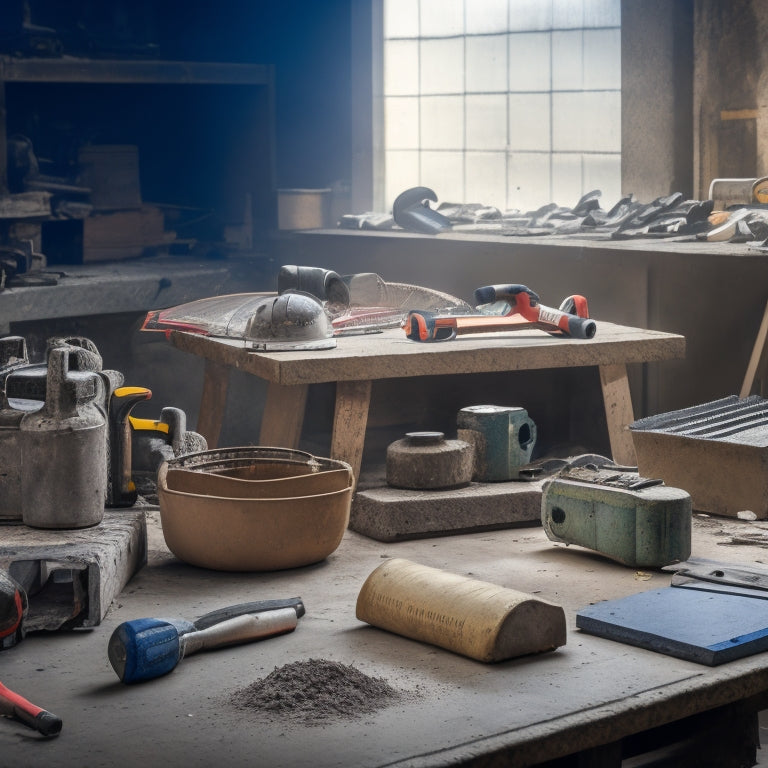
Top Tools for Cutting Concrete Like a Pro
Share
To cut concrete like a pro, you'll need the right tools and techniques. Start with essential safety gear, including protective eyewear, hearing protection, and dust masks. Then, choose from a range of specialized tools, such as handheld concrete saws for precision cuts, walk-behind saws for large projects, and concrete demolition hammers for heavy-duty tasks. Don't forget diamond blades for smooth cuts, rotary hammers for drilling and breaking, and electric concrete grinders for finishing touches. With the right tools and a solid understanding of cutting techniques, you'll be well on your way to achieving professional results - and there's more to learn to take your concrete cutting skills to the next level.
Key Takeaways
• Essential safety gear, including protective eyewear, hearing protection, and dust masks, is crucial for operators when cutting concrete.
• Handheld concrete saws offer precision, control, and comfort for cutting in tight spaces and intricate designs.
• Walk-behind saws are ideal for large, straight cuts in slabs and paving projects, with customization options for project needs.
• Diamond blades are critical for achieving smooth cuts, and selecting the right blade depends on concrete type and desired cutting speed.
• Rotary hammers and hydraulic concrete splitters provide heavy-duty power and precision for drilling, breaking, and splitting thick concrete.
Essential Safety Gear for Operators
When operating concrete cutting tools, you must wear essential safety gear to prevent injuries and fatalities. This gear isn't optional; it's mandatory. Concrete cutting tools can generate high-velocity debris, intense noise, and hazardous dust, making it vital to protect yourself adequately.
First and foremost, you need protective eyewear that meets the ANSI Z87.1 standard. This will safeguard your eyes from flying particles, dust, and chemical splashes. Verify the eyewear fits snugly and provides an unobstructed view.
Next, don't forget hearing protection. Concrete cutting tools can produce sound levels exceeding 90 decibels, which can cause permanent hearing damage. Wear earplugs or earmuffs that meet the OSHA hearing protection standard.
Additionally, consider wearing a dust mask or respirator to prevent inhaling silica dust and other hazardous particles.
Finally, wear durable, long-sleeved clothing, gloves, and steel-toed boots to protect your skin and feet from cuts, abrasions, and crushing injuries.
Handheld Concrete Saws for Precision
With safety gear in place, you're ready to tackle precision concrete cutting tasks with handheld concrete saws, which offer unparalleled versatility and maneuverability for making precise cuts in tight spaces. These compact powerhouses are ideal for intricate cuts, such as curved lines, corners, and small openings. Handheld saws also excel in confined areas, like crawl spaces or narrow corridors, where larger saws can't fit.
| Handheld Saw Advantages | Precision Cutting Techniques |
|---|---|
| Compact size for tight spaces | Curved cuts using a steady, sweeping motion |
| Lightweight for reduced fatigue | Straight cuts using a slow, controlled pace |
| Increased control for precise cuts | Angled cuts using a gentle, tilting motion |
When using handheld saws, it is crucial to maintain a firm grip, keep the saw blade straight, and apply gentle to moderate pressure. This will help you achieve smooth, accurate cuts with minimal vibration. By mastering precision cutting techniques and leveraging the advantages of handheld saws, you'll be able to tackle even the most complex concrete cutting tasks with confidence and precision.
Walk-Behind Saws for Large Cuts
As you graduate to larger concrete cutting projects, you'll find walk-behind saws are the ideal choice for making long, straight cuts in large slabs, paving, and floors. These powerful tools offer several walk-behind advantages, including increased precision, control, and efficiency. With a walk-behind saw, you can make cuts of up to 12 inches deep and 24 inches wide, making them perfect for large-scale projects.
When using a walk-behind saw, it's important to employ proper cutting techniques to achieve accurate and clean cuts. This includes maintaining a consistent speed, applying gentle to moderate pressure, and using a steady, back-and-forth motion. You should also verify the saw is properly aligned with the cut line and the blade is adequately cooled to prevent overheating.
Walk-behind saws are available in various engine sizes and blade configurations, so it's vital to choose the right one for your specific project needs. By selecting the appropriate saw and mastering proper cutting techniques, you'll be able to tackle even the largest concrete cutting projects with ease and precision.
Concrete Demolition Hammer Options
You'll need a reliable concrete demolition hammer to break up and remove concrete, and several options are available to suit your specific project requirements.
Demolition hammer types vary, but the most common include electric, pneumatic, and hydraulic models. Electric demolition hammers are suitable for smaller projects and offer lower vibration levels, making them ideal for indoor use. Pneumatic models, on the other hand, provide more power and are often used for larger-scale demolition projects. Hydraulic demolition hammers are the most powerful option, typically used for heavy-duty applications like bridge demolition.
When selecting a demolition hammer, consider vibration control features to reduce operator fatigue and improve safety. Look for models with anti-vibration handles, shock-absorbing materials, and adjustable grip systems.
Additionally, consider the hammer's weight, balance, and ergonomics to guarantee comfortable use over extended periods.
Rotary Hammers for Heavy Duty
When you're tackling heavy-duty concrete cutting tasks, you'll need a rotary hammer that can handle the toughest jobs.
You'll be hammering into concrete foundations, drilling through hardened surfaces, and breaking up thick slabs, so it's crucial to choose the right tool for the task.
Hammering Concrete Foundations
With heavy-duty concrete cutting projects, you'll need a rotary hammer capable of delivering high-torque pounding to break through thick, reinforced foundations. This is especially important when working on foundation stability, where precise hammering techniques are essential to prevent structural damage.
When hammering concrete foundations, it's essential to maintain control over the tool and the material being cut. This can be achieved by:
-
Using a rotary hammer with a high power-to-weight ratio for increased efficiency and reduced fatigue.
-
Selecting the appropriate hammering mode (e.g., rotary hammer or chiseling) based on the type of concrete and the desired outcome.
-
Wearing protective gear, such as gloves and safety glasses, to prevent injury from flying debris and tool kickback.
Drilling Through Hardened
By leveraging the immense power of a rotary hammer, you can successfully drill through hardened concrete, asphalt, and other tough materials that would be impossible to penetrate with lesser tools.
These heavy-duty machines are designed to tackle the toughest core drilling tasks, making them ideal for projects that require precision and accuracy.
When working with hardened surfaces, it's crucial to choose the right bit for the job. Carbide-tipped bits are perfect for drilling through concrete, as they can withstand the intense heat and friction generated during the drilling process.
Additionally, using a rotary hammer with a high torque output will guarantee that you can drill through even the most challenging materials with ease.
Remember to always follow safety protocols when operating a rotary hammer, as the high-speed rotation and heavy vibrations can be hazardous if not handled properly.
Breaking Up Slabs
You'll need a rotary hammer capable of delivering massive force to shatter and break up thick concrete slabs, which is where heavy-duty models come into play.
When it comes to slab preparation techniques, a powerful rotary hammer is crucial for effective demolition methods. These tools are designed to handle the toughest concrete breaking tasks, making them ideal for heavy-duty applications.
Here are some key considerations when selecting a rotary hammer for breaking up slabs:
-
Power output: Look for a rotary hammer with a high power output, measured in amps or watts, to guarantee it can deliver the necessary force to break up thick slabs.
-
Bit capacity: Choose a rotary hammer with a large bit capacity to accommodate larger bits and increase productivity.
-
Ergonomic design: Opt for a rotary hammer with an ergonomic design that reduces fatigue and improves control, allowing you to work for extended periods.
Diamond Blades for Smooth Cuts
When you're working with diamond blades, you'll quickly realize that selecting the right blade is essential for achieving smooth cuts.
You'll need to take into account factors like the type of concrete, the desired cutting speed, and the blade's durability to get the best results.
Blade Selection Matters
Selecting the right diamond blade is essential for achieving smooth cuts, as it directly impacts the quality of your concrete cutting results.
You'll want to evaluate the type of concrete you're working with, as well as the desired finish, to choose the best blade for the job.
When it comes to blade materials, you've got options. You can opt for a blade with a steel core and diamond-coated edges for a more aggressive cut, or a blade with a segmented rim for a smoother finish.
Whatever you choose, make sure you're maintaining your blade properly.
Here are a few key considerations to keep in mind:
-
Blade maintenance: Regularly cleaning and inspecting your blade can help extend its lifespan and prevent damage.
-
Blade hardness: Softer blades are better suited for harder concrete, while harder blades are better for softer concrete.
-
Segmented vs. continuous rim: Segmented rims are better for heavy-duty cutting, while continuous rims are better for finer cuts.
Cutting Depths Explained
As you prepare to make precise cuts in concrete, it's crucial to understand the importance of cutting depths.
Two key factors - the diamond blade's cutting depth and its concentration of diamonds per square inch - determine the smoothness of your concrete cuts. A deeper cutting depth allows for faster cutting, but may compromise on smoothness. Conversely, a shallower cutting depth guarantees a smoother finish, but may slow down the cutting process.
When selecting a diamond blade, consider the recommended cutting depth for your specific project. Depth measurements typically range from 1/8 inch to 1 inch, depending on the blade type and application. For example, a 1/4 inch cutting depth is ideal for making decorative cuts, while a 1/2 inch depth is better suited for heavy-duty demolition work.
Mastering various cutting techniques, such as push cutting or pull cutting, will also help you achieve the desired level of smoothness. By understanding the interplay between cutting depth and diamond concentration, you'll be able to make precise, professional-grade cuts in concrete with ease.
Concrete Cutting Chisels for Edges
You'll turn to concrete cutting chisels specifically designed for edges when precision and control are paramount in your project. These chisels are ideal for edge finishing techniques that require a high level of accuracy, such as creating sharp corners or removing small amounts of concrete.
When working with concrete cutting chisels for edges, it's crucial to follow proper chisel maintenance tips to guarantee peak performance and extend the tool's lifespan.
Here are some key considerations when using concrete cutting chisels for edges:
-
Select the right chisel angle: Choose a chisel with an angle that matches the edge you're working on. A 45-degree angle is common for most edge finishing tasks.
-
Use the correct striking technique: Hold the chisel firmly and strike it with a controlled, glancing blow to avoid damaging the tool or the concrete.
-
Keep the chisel clean and sharp: Regularly clean and sharpen your chisel to maintain its cutting edge and prevent it from becoming dull or clogged with debris.
Electric Concrete Grinders for Finishing
When precision and speed are essential for finishing concrete surfaces, electric concrete grinders prove indispensable tools for achieving a high-quality finish. These grinders are designed to remove imperfections, smooth out rough edges, and prepare surfaces for further treatment. With the right electric grinder features, you can achieve a polished finish that meets your project's requirements.
Here are some key electric grinder features to evaluate for surface finishing techniques:
| Feature | Description | Benefit |
|---|---|---|
| Variable Speed | Adjustable RPM for ideal performance | Increased control and precision |
| Dust Collection | Integrated system for minimizing dust and debris | Improved air quality and reduced cleanup |
| Ergonomic Design | Comfortable grip and balanced weight distribution | Reduced fatigue and increased productivity |
| Diamond Cup Wheels | Aggressive cutting and grinding capabilities | Faster material removal and improved finish |
Hydraulic Concrete Splitters for Power
For more heavy-duty concrete cutting applications that require brute force and precision, hydraulic concrete splitters offer unparalleled power and control. You'll appreciate the hydraulic efficiency of these machines, which enables you to tackle even the toughest concrete cutting tasks with ease.
When choosing a hydraulic concrete splitter, consider the following advantages:
-
High-pressure hydraulic system: Provides maximum force and precision for fast and efficient concrete cutting.
-
Robust construction: Built to withstand heavy-duty use and harsh job site conditions.
-
Ergonomic design: Reduces operator fatigue and increases productivity.
With a hydraulic concrete splitter, you'll experience improved performance, reliability, and durability. These machines are designed to deliver maximum power and control, making them ideal for large-scale concrete cutting projects.
Whether you're a professional contractor or a serious DIY enthusiast, a hydraulic concrete splitter is an essential tool for achieving professional-grade results. By leveraging the splitter advantages, you'll be able to complete your projects faster, safer, and more efficiently.
Frequently Asked Questions
What Is the Ideal Blade Speed for Cutting Concrete?
When you're cutting concrete, you'll want to get the blade speed just right.
Ideally, you're aiming for 3,500 to 4,500 RPM, depending on the blade type and cutting technique.
For instance, diamond blades usually require higher speeds, while abrasive blades work better at lower speeds.
Remember, the wrong speed can lead to premature wear, reduced accuracy, or even damage to the blade.
Get this right, and you'll be cutting like a pro in no time!
Can I Use a Concrete Saw to Cut Through Rebar?
When it comes to cutting through rebar, you'll need to choose the right saw for the job.
Not all concrete saws are designed for rebar cutting, so select a saw specifically designed for this task.
Look for a saw with a blade that can handle the density of rebar, and consider a saw with a higher horsepower to make the cut more efficiently.
How Often Should I Lubricate My Concrete Cutting Tools?
Just like a well-oiled machine, your concrete cutting tools need regular lubrication to run smoothly and efficiently.
You should lubricate your tools every 30 minutes to an hour, depending on the intensity of use and environmental conditions. This frequency guarantees peak performance, reduces wear and tear, and prevents overheating.
What Is the Best Way to Store Concrete Cutting Blades?
When storing concrete cutting blades, you'll want to prioritize proper blade maintenance tips to extend their lifespan.
First, clean the blades thoroughly to remove any debris or residue.
Then, store them in a dry, cool environment, avoiding direct sunlight and moisture.
Keep them away from other tools to prevent scratching or damage.
Can I Rent Concrete Cutting Equipment Instead of Buying?
If you're considering cutting concrete, you might wonder if renting equipment is a better option than buying.
Renting can provide significant cost benefits, especially for one-time or infrequent projects. You'll avoid the upfront investment and storage concerns.
Research local rental options to find the right equipment for your job.
Compare rental rates to purchase prices to determine the most cost-effective choice for your specific needs.
Conclusion
You've got the right tools for the job, now it's time to cut concrete like a pro!
Remember, 'well begun is half done.' With these top tools, you'll be well on your way to making precise cuts, demolishing old concrete, and finishing with a smooth edge.
From handheld saws to hydraulic splitters, you've got the arsenal to tackle any concrete cutting task.
So, get to work and let your expertise shine!
Related Posts
-

Must-Have Handheld Tools for Concrete Repair
When tackling a concrete repair project, it is crucial to have the right handheld tools to achieve a professional fin...
-

5 Best Tools for Stamping Concrete Walls
When it comes to stamping concrete walls, you'll need a range of specialized tools to achieve the desired texture and...
-

10 Best Tools for Sealed Concrete Finishing Success
When it comes to sealed concrete finishing success, you need a robust arsenal of specialized tools. Start with essent...


